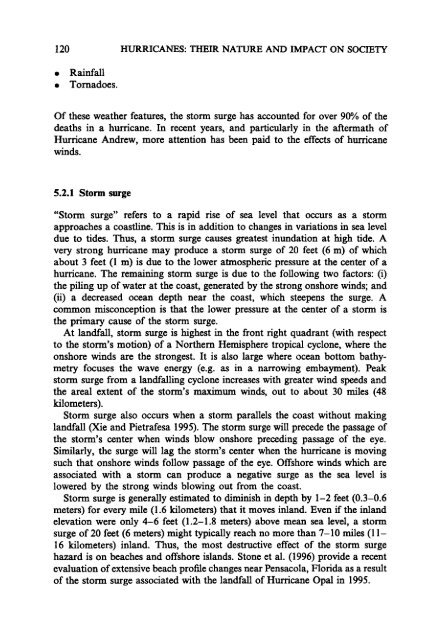Hurricanes: Their Nature and Impacts on Society - Climate Science ...
Hurricanes: Their Nature and Impacts on Society - Climate Science ...
Hurricanes: Their Nature and Impacts on Society - Climate Science ...
Create successful ePaper yourself
Turn your PDF publications into a flip-book with our unique Google optimized e-Paper software.
120 HURRICANES: THEIR NATURE AND IMPACT ON SOCIETY<br />
.Rainfall<br />
.Tornadoes.<br />
Of these weather features, the st<strong>on</strong>n surge has accounted for over 900/0 of the<br />
deaths in a hurricane. In recent years, <str<strong>on</strong>g>and</str<strong>on</strong>g> particularly in the aftennath of<br />
Hurricane Andrew, more attenti<strong>on</strong> has been paid to the effects of hurricane<br />
winds.<br />
5.2.1 St<strong>on</strong>n surge<br />
"Storm surge" refers to a rapid rise of sea level that occurs as a storm<br />
approaches a coastline. This is in additi<strong>on</strong> to changes in variati<strong>on</strong>s in sea level<br />
due to tides. Thus, a storm surge causes greatest inundati<strong>on</strong> at high tide. A<br />
very str<strong>on</strong>g hurricane may produce a storm surge of 20 feet (6 m) of which<br />
about 3 feet (1 m) is due to the lower atmospheric pressure at the center of a<br />
hurricane. The remaining storm surge is due to the following two factors: (i)<br />
the piling up of water at the coast, generated by the str<strong>on</strong>g <strong>on</strong>shore winds; <str<strong>on</strong>g>and</str<strong>on</strong>g><br />
(ii) a decreased ocean depth near the coast, which steepens the surge. A<br />
comm<strong>on</strong> misc<strong>on</strong>cepti<strong>on</strong> is that the lower pressure at the center of a storm is<br />
the primary cause of the storm surge.<br />
At l<str<strong>on</strong>g>and</str<strong>on</strong>g>fall, storm surge is highest in the fr<strong>on</strong>t right quadrant (with respect<br />
to the storm's moti<strong>on</strong>) of a Northern Hemisphere tropical cycl<strong>on</strong>e, where the<br />
<strong>on</strong>shore winds are the str<strong>on</strong>gest. It is also large where ocean bottom bathymetry<br />
focuses the wave energy (e.g. as in a narrowing embayment). Peak<br />
storm surge from a l<str<strong>on</strong>g>and</str<strong>on</strong>g>falling cycl<strong>on</strong>e increases with greater wind speeds <str<strong>on</strong>g>and</str<strong>on</strong>g><br />
the areal extent of the storm's maximum winds, out to about 30 miles (48<br />
kilometers).<br />
Storm surge also occurs when a storm parallels the coast without making<br />
l<str<strong>on</strong>g>and</str<strong>on</strong>g>fall (Xie <str<strong>on</strong>g>and</str<strong>on</strong>g> Pietrafesa 1995). The storm surge will precede the passage of<br />
the storm's center when winds blow <strong>on</strong>shore preceding passage of the eye.<br />
Similarly, the surge will lag the storm's center when the hurricane is moving<br />
such that <strong>on</strong>shore winds follow passage of the eye. Offshore winds which are<br />
associated with a storm can produce a negative surge as the sea level is<br />
lowered by the str<strong>on</strong>g winds blowing out from the coast.<br />
Storm surge is generally estimated to diminish in depth by 1-2 feet (0.3-0.6<br />
meters) for every mile (1.6 kilometers) that it moves inl<str<strong>on</strong>g>and</str<strong>on</strong>g>. Even if the inl<str<strong>on</strong>g>and</str<strong>on</strong>g><br />
elevati<strong>on</strong> were <strong>on</strong>ly 4-6 feet (1.2-1.8 meters) above mean sea level, a storm<br />
surge of 20 feet (6 meters) might typically reach no more than 7-10 miles (11-<br />
16 kilometers) inl<str<strong>on</strong>g>and</str<strong>on</strong>g>. Thus, the most destructive effect of the storm surge<br />
hazard is <strong>on</strong> beaches <str<strong>on</strong>g>and</str<strong>on</strong>g> offshore isl<str<strong>on</strong>g>and</str<strong>on</strong>g>s. St<strong>on</strong>e et al. (1996) provide a recent<br />
evaluati<strong>on</strong> of extensive beach profile changes near Pensacola, Florida as a result<br />
of the storm surge associated with the l<str<strong>on</strong>g>and</str<strong>on</strong>g>fall of Hurricane Opal in 1995.














